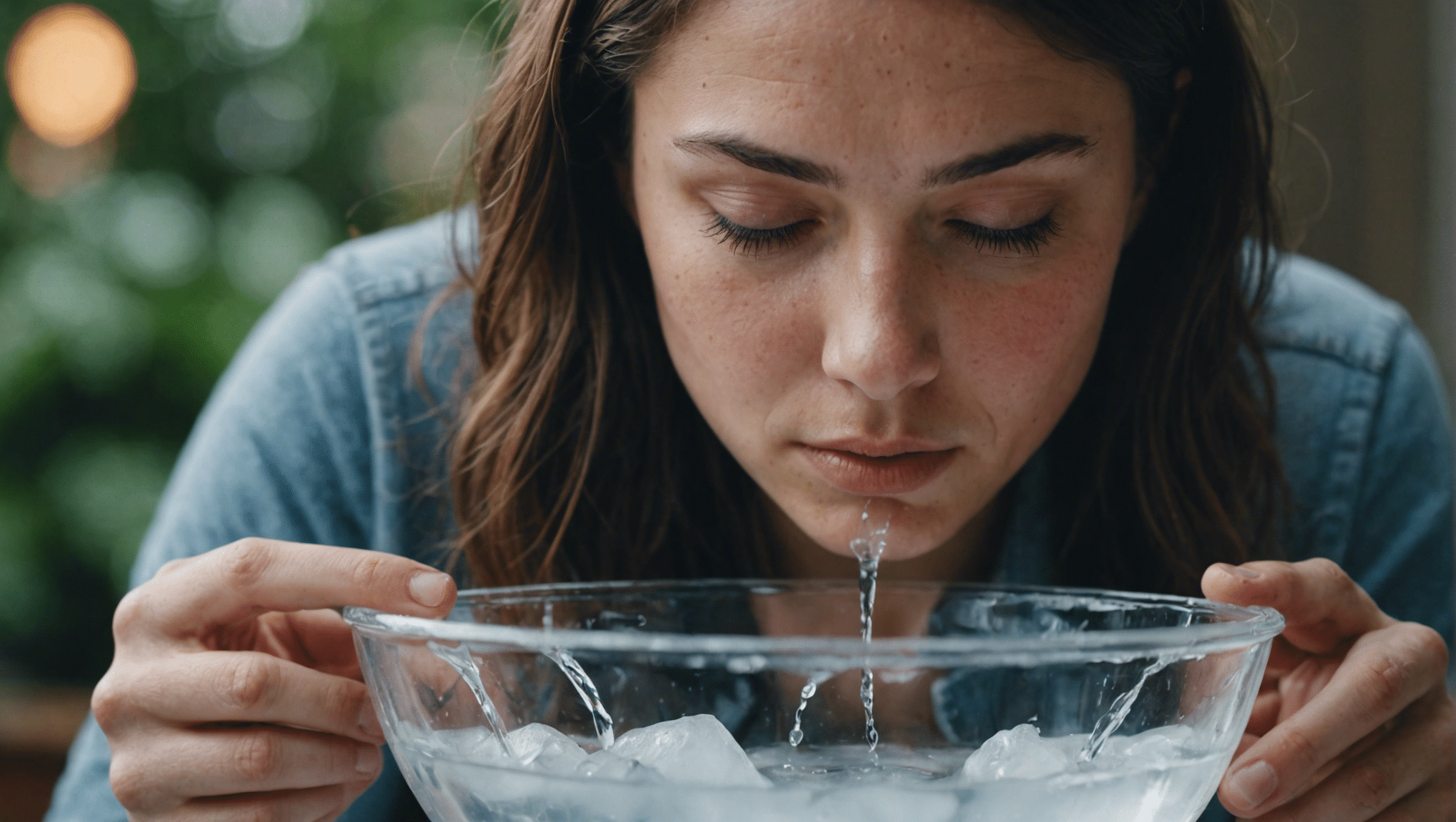Cold water face immersion involves dunking your face in cold water. It may offer benefits like reducing stress and increasing alertness 1. This article compares different cold therapy methods, including face immersion, ice baths, cold showers, and cryotherapy chambers.
What are the benefits of cold water face immersion?
Cold water face immersion is believed to provide benefits such as increased alertness, reduced stress and anxiety, improved circulation, activation of the vagus nerve and parasympathetic nervous system, and a calming effect.
This blog is part of a series on “cold exposure.” The next blog is about cold showers.
Key Benefits of Cold Water Face Immersion
- Activates the vagus nerve and parasympathetic nervous system
- Promotes a calming effect and reduces anxiety
- Increases alertness and mental clarity
- Supports improved circulation and stress reduction
- Easy to incorporate into daily routines
- Requires minimal equipment or preparation
- Offers a refreshing and invigorating experience
Cold Water Face Immersion: Overview
Dunking your face in cold water, a practice known as cold water face immersion involves submerging your face in a bowl or basin filled with ice-cold water for a brief period. This simple yet invigorating technique is believed to offer a range of potential benefits. Stimulating the vagus nerve may activate the parasympathetic nervous system, promoting a sense of calm and reducing anxiety levels.
The key is to take slow, deep breaths before immersing your face, and then hold your breath while submerged. After 10-15 seconds, slowly exhale and repeat the desired process. Like a refreshing splash on a hot day, cold water face immersion can leave you feeling revitalized and alert, making it a popular morning ritual for some.
Ice Baths: Invigorating Chill Therapy
Stepping up the intensity, ice baths involve immersing a significant portion of your body in a tub or container filled with ice-cold water. This ancient practice, embraced by athletes and wellness enthusiasts alike, aids muscle recovery, reduces inflammation, and boosts overall well-being. Prepare for a chilly challenge as you gradually lower yourself into the icy depths.
While the initial shock can be, well, shocking, the benefits may be worth enduring the temporary discomfort. Proponents claim ice baths can alleviate conditions like arthritis, headaches, and even depression. Just follow proper safety protocols, such as monitoring your exposure time and gradually warming up afterward. After all, you don’t want to turn into a human popsicle!
Cold Showers: Accessible Hydrotherapy Routine
Cold showers offer a practical solution for those seeking a more convenient and less extreme form of cold therapy. Adjust the temperature dial to its chilliest setting and embrace the icy cascade. This invigorating ritual can be easily incorporated into your daily routine, making it a refreshing way to start or end your day.

Beyond the initial shock factor, cold showers boost circulation, improve skin health, and even enhance mood. And let’s not forget the potential benefits for hair and scalp health – a perfect excuse to belt out your favorite tunes while lathering up in the chilly stream. Just be sure to acclimate to the colder temperatures to avoid unpleasant surprises gradually.
Cryotherapy: Advanced Cold Exposure Therapy
Cryotherapy chambers offer a high-tech solution for those seeking the cutting edge of cold therapy. These specialized chambers expose the body to extremely low temperatures, typically ranging from -100°C to -140°C (-148°F to -220°F). While willingly entering such a frigid environment may send shivers down your spine, proponents claim many potential benefits.
From reducing inflammation and pain to improving sleep quality and boosting mood, cryotherapy is touted as a powerful tool for overall well-being. However, it’s important to note that this advanced therapy should only be undertaken under professional supervision and with proper precautions. After all, you don’t want to end up as a human ice cube!
| Method | Intensity | Accessibility | Potential Benefits |
|---|---|---|---|
| Cold Water Face Immersion | Low | High | Stress reduction, increased alertness |
| Cold Showers | Moderate | High | Improved circulation, skin health |
| Ice Baths | High | Moderate | Muscle recovery, reduced inflammation |
| Cryotherapy Chambers | Extreme | Low | Pain relief, mood enhancement |
Comparing Efficacy and Safety Profiles
As with any wellness practice, it’s crucial to understand the potential risks and benefits associated with each cold therapy method. While cold water face immersion and cold showers are generally considered safe for most individuals, ice baths and cryotherapy may pose higher risks if not practiced properly.
Exposure time, water temperature, and individual health conditions should be carefully considered. It’s always advisable to consult with a healthcare professional, especially if you have underlying medical conditions or concerns. Remember, the goal is to embrace the chill while prioritizing your safety and well-being.
Personal Thoughts
As someone who has grappled with chronic stress and anxiety, I find cold water face immersion to be a simple yet powerful tool in my daily routine. It provides a moment of refreshing clarity, allowing me to reset and approach each day with a renewed sense of calm.
While it may not be a panacea, this practice has become a grounding ritual that complements the other evidence-based techniques I’ve incorporated. It is a gentle reminder to embrace mindfulness and prioritize self-care, even amidst the demands of a busy lifestyle.
Frequently Asked Questions
How do you perform cold water face immersion?
Fill a bowl or basin with cold water and ice to perform cold water face immersion. Take a deep breath, then slowly submerge your face into the water for 10-15 seconds while holding your breath. Exhale slowly as you lift your face out. Repeat as desired.
Is cold water face immersion safe for everyone?
Cold water face immersion is generally safe for most people. Still, those with certain medical conditions like heart disease, Raynaud’s phenomenon, or respiratory issues should consult a doctor before trying it. Gradually acclimating to the cold water is also recommended.
How often should you do cold water face immersion?
There is no set frequency, but many practitioners recommend doing cold water face immersion once or twice daily, such as in the morning and evening. Listening to your body and adjusting the frequency as needed is best.
Can cold water face immersion cause skin irritation?
Cold water face immersion is generally not known to cause skin irritation, but those with sensitive skin or conditions like rosacea may want to proceed cautiously. Using lukewarm water instead of ice water can help minimize potential irritation.




